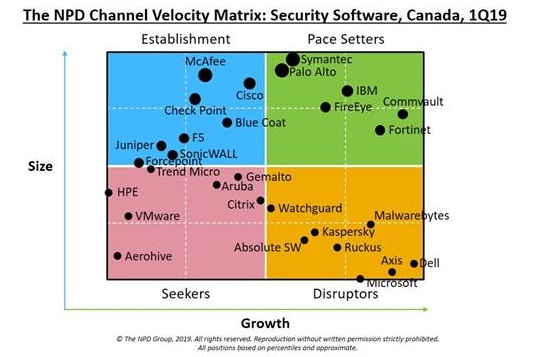Designed to promote fairness, transparency and economy in public sector purchasing, procurement practices have become pedantic. In many public organizations, centrally managed procurement offices have become rules bound over time, focused more on buying processes than on meeting the dynamic or unique needs of individual departments. The result has been delay or the delivery of pens rather than pencils, and with it, reduced ability to improve productivity. With the ongoing digitization of manual processes, this challenge has become more acute: while standardization to enable bulk purchases of physical items carried some potential for misaligned needs fulfillment, managing the design and roll out of highly complex, multi-vendor IT solutions aimed at addressing specific functional capabilities via traditional procurement models has proved increasingly problematic. And as governments and citizens come to rely more heavily on IT systems for service delivery – the lure of technologies, such as cloud computing, for secure environments such as smart cities – require new ways of consuming IT, as they amplify calls for new approaches to acquisition to ensure governments receive maximum benefit from technology investments.
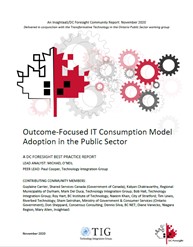 To address growing demand and changing acquisition requirements, public sector organizations have begun to evolve new approaches to IT procurement. Many of these are detailed in the most recent InsightaaS research report, Best Practices in Outcome Focused IT Consumption Model Adoption, which flips traditional procurement on its head, advising buyers to focus first on the intended business result, rather than on component lists. With their lens trained on “outcomes,” the report argues, buyers are led more intuitively to a solutions orientation, a tactic that more closely aligns with IT procurement. In its turn, a solutions-based approach begs the involvement of multiple groups in scoping the most appropriately technologies. Cloud technologies, for example, might provide the infrastructure backbone needed to support a solution, while software and services that provide discrete functionality are delivered by development, managed services, consulting, or integration partners. The involvement of multiple stakeholders in outcome focused IT consumption is well represented by the range of experts who contributed their insights and interest to the new report.
To address growing demand and changing acquisition requirements, public sector organizations have begun to evolve new approaches to IT procurement. Many of these are detailed in the most recent InsightaaS research report, Best Practices in Outcome Focused IT Consumption Model Adoption, which flips traditional procurement on its head, advising buyers to focus first on the intended business result, rather than on component lists. With their lens trained on “outcomes,” the report argues, buyers are led more intuitively to a solutions orientation, a tactic that more closely aligns with IT procurement. In its turn, a solutions-based approach begs the involvement of multiple groups in scoping the most appropriately technologies. Cloud technologies, for example, might provide the infrastructure backbone needed to support a solution, while software and services that provide discrete functionality are delivered by development, managed services, consulting, or integration partners. The involvement of multiple stakeholders in outcome focused IT consumption is well represented by the range of experts who contributed their insights and interest to the new report.
Led by InsightaaS lead analyst Michael O’Neil and peer lead, Paul Cooper, president of Canadian operations for the Technology Integration Group (TIG), Best Practices in Outcome Focused IT Consumption Model Adoption benefited from the guidance of multiple DC Foresight community members, including Guylaine Carrière, Shared Services Canada/Government of Canada; Kalyan Chakravarthy, Regional Municipality of Durham; Mark Del Duca, Technology Integration Group; Bob Hall, Technology Integration Group; Roy Hart, BCIT; Naeem Khan, City of Stratford; Tim Lewis, Riverbed Technologies; Sham Satrohan, Ontario Ministry of Government and Consumer Services; Don Sheppard, Consensus Consulting Services; Dennis Silva, BCNET; Diane Vanecko, Niagara Region; and Mary Allen, InsightaaS.

To promote some of the report learnings, InsightaaS hosted a well attended webinar at the end of May designed to highlight key research input on this topic. Facilitator Michael O’Neil introduced the discussion, pointing to three factors that are driving increased interest in outcome-based IT consumption models: the increase in technology options, such as cloud computing; the rapid pace of technology change, and its scope of usage, particularly in the pandemic environment; and growth in digital awareness. Together, these drivers are encouraging a shift to solutions-based, IT consumption within the public sector, and new ways of acquiring technology.
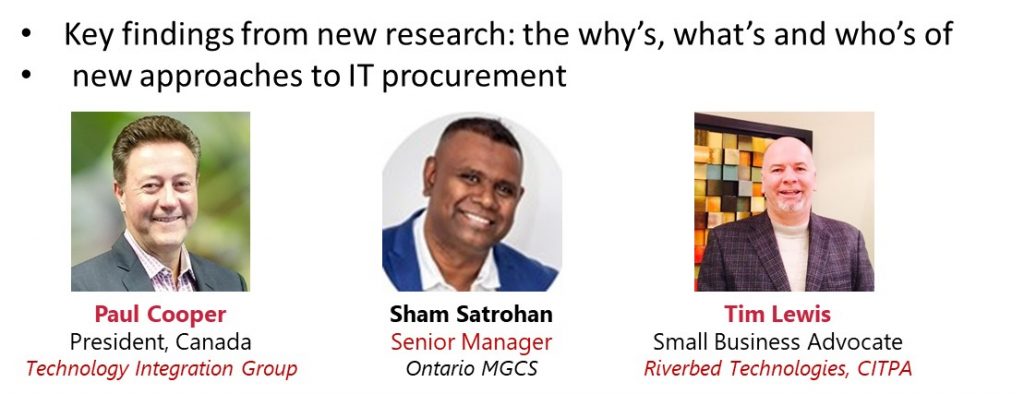
The webinar also featured presentations from report contributors who spoke to specific slides from the report outlining best practice approaches. Tim Lewis, regional sales manager at Riverbed Technologies and the company’s special advisor to the board of CITPA, the Canadian IT Providers Association, noted that evolution to an outcome-based procurement model has been ongoing – over the last 30 years – in response to traditional methods that take too long, and provide little opportunity for innovation. What has been missing, he argued, is a measure of value that extends beyond component specification. To avoid “tech spec procurement,” he explained, value-based procurement must develop solutions focus, which entails good supplier management, using advanced success metrics with targeted outcomes and procurement relevant measures. Ultimately, the goal is to support greater agility in procurement through a shift from reliance on a few champions to creation of a more established culture of innovation.
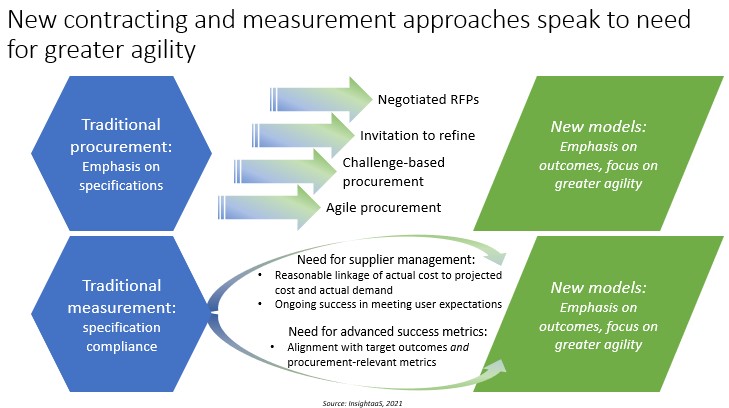
Building on this notion of evolution, Paul Cooper of TIG noted that “it’s all about change” away from a commodity-based procurement perspective. It’s necessary, he explained, to think about procurement in a change management context, and here, existing best practice methodologies, such as Agile, can help. To ensure successful deployment of these methodologies, however, it’s critical that all stakeholders – including business users of the technology, the IT team, services teams, and procurement – be involved. Inclusivity, he added, is key to enacting a shift in culture. This broad involvement also includes suppliers according to Cooper: vendors must also be engaged, in a new way that allows them to contribute value, such as domain knowledge that is specific to individual departmental needs. While the public sector operates within communities of entities with common needs, he noted, they each have unique missions that must be addressed in solutions development. At a procurement level, vendors engagement must satisfy fairness, inclusion, and the governance and risk management requirements of the public sector.

Representing government, Sham Satrohan, senior manager of the Ontario Ministry of Government and Consumer Services, described this broad engagement at all levels as a “value chain” that will help government move from operation on a “transactional basis to full automation that can drive new data insights.” Drawing on his internal perspective, Satrohan was able to articulate specific stakeholder interests and issues. While executives are looking for consumption-based procurement to deliver cost savings, IT leaders must address staffing issues, and changing patterns of consumption. For their part, IT users and consumers will need to build greater self sufficiency in technology usage, while suppliers must learn to create working partnerships around the creation of integrated solutions. Since this search for the best consumption for price can add complexity, he noted, a shift to managed service may be the best approach.
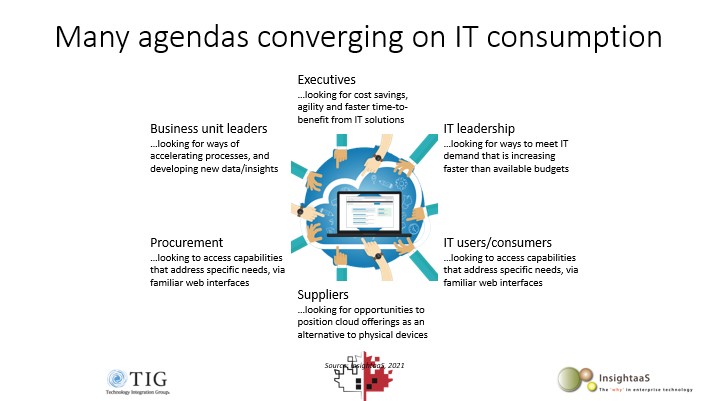
Capstone to the webinar was a ‘value chain’ team presentation organized by Guylaine Carrière, director of the Centre of Expertise in Agile and Innovative Procurement for Shared Services Canada. Carrière’s group included both internal and external experts: Nadine Charron, Employment and Social Development Canada; Doug Bakewell, Shared Services Canada, Michele Lajeunesse, TECHNATION; and Nilufer Erdebil, Spring2 Innovation.

Based on their involvement in the initiative, these offered unique insights into the need for, and the actual creation of an advanced example of outcomes focused procurement – the Agile 3.0 model developed at Shared Services under the leadership of Guylaine Carrière. According to Carrière, Agile 3.0 “is not about technology, it’s about people.” It is focused on addressing business objectives through a process that develops four demo/pilot projects to create a specific solution, an approach that she believes provides contract flexibility as well as transparency. Adopting a lively Q&A format, Carrière directed different questions to team presenters to draw out the needs and contributions of each role – Charron, who acted as the solution client, Bakewell who specializes in turning technical components into a problem statement, Erdebil, who’s design thinking for the initiative involved the development of end user personas, but also empathy and journey mapping to allow the inclusion of end user needs in the MVP that can evolve with the solution, and Lajeunesse, who supported creation of a digital marketplace that would address need for the inclusion of small businesses in Shared Services Canada work.
To learn more about this unique Shared Services collaboration, and report presentations, access the webinar video here: https://vimeo.com/557667780
The InsightaaS Best Practices in Outcome Focused IT Consumption Model Adoption report is available here: https://insightaas.formstack.com/forms/report_download_outcome_focused





